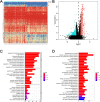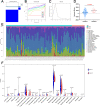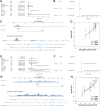Comprehensive analysis of prognostic tumor microenvironment-related genes in osteosarcoma patients
- PMID: 32854645
- PMCID: PMC7450807
- DOI: 10.1186/s12885-020-07216-2
Comprehensive analysis of prognostic tumor microenvironment-related genes in osteosarcoma patients
Abstract
Background: Tumor microenvironment (TME) plays an important role in malignant tumors. Our study aimed to investigate the effect of the TME and related genes in osteosarcoma patients.
Methods: Gene expression profiles and clinical data of osteosarcoma patients were downloaded from the TARGET dataset. ESTIMATE algorithm was used to quantify the immune score. Then, the association between immune score and prognosis was studied. Afterward, a differential analysis was performed based on the high- and low-immune scores to determine TME-related genes. Additionally, Cox analyses were performed to construct two prognostic signatures for overall survival (OS) and disease-free survival (DFS), respectively. Two datasets obtained from the GEO database were used to validate signatures.
Results: Eighty-five patients were included in our research. The survival analysis indicated that patients with higher immune score have a favorable OS and DFS. Moreover, 769 genes were determined as TME-related genes. The unsupervised clustering analysis revealed two clusters were significantly related to immune score and T cells CD4 memory fraction. In addition, two signatures were generated based on three and two TME-related genes, respectively. Both two signatures can significantly divide patients into low- and high-risk groups and were validated in two GEO datasets. Afterward, the risk score and metastatic status were identified as independent prognostic factors for both OS and DFS and two nomograms were generated. The C-indexes of OS nomogram and DFS nomogram were 0.791 and 0.711, respectively.
Conclusion: TME was associated with the prognosis of osteosarcoma patients. Prognostic models based on TME-related genes can effectively predict OS and DFS of osteosarcoma patients.
Keywords: Immune features; Nomogram; Osteosarcoma; Prognosis; Tumor microenvironment.
Conflict of interest statement
The authors declare that they have no competing interests.
Figures






Similar articles
-
Develop a Novel Signature to Predict the Survival and Affect the Immune Microenvironment of Osteosarcoma Patients: Anoikis-Related Genes.J Immunol Res. 2024 Mar 27;2024:6595252. doi: 10.1155/2024/6595252. eCollection 2024. J Immunol Res. 2024. PMID: 39431237 Free PMC article.
-
A prognostic glycolysis-related gene signature in osteosarcoma: implications for metabolic programming, immune microenvironment, and drug response.PeerJ. 2025 Apr 29;13:e19369. doi: 10.7717/peerj.19369. eCollection 2025. PeerJ. 2025. PMID: 40321814 Free PMC article.
-
Comprehensive investigation of tumor immune microenvironment and prognostic biomarkers in osteosarcoma through integrated bulk and single-cell transcriptomic analysis.Front Immunol. 2024 Jul 23;15:1424950. doi: 10.3389/fimmu.2024.1424950. eCollection 2024. Front Immunol. 2024. PMID: 39108264 Free PMC article.
-
Signature constructed by glycolysis-immune-related genes can predict the prognosis of osteosarcoma patients.Invest New Drugs. 2022 Aug;40(4):818-830. doi: 10.1007/s10637-022-01228-4. Epub 2022 Apr 18. Invest New Drugs. 2022. PMID: 35435626 Review.
-
The Immune Landscape of Osteosarcoma: Implications for Prognosis and Treatment Response.Cells. 2021 Jul 2;10(7):1668. doi: 10.3390/cells10071668. Cells. 2021. PMID: 34359840 Free PMC article. Review.
Cited by
-
CCR4, CCR8, and P2RY14 as Prognostic Factors in Head and Neck Squamous Cell Carcinoma Are Involved in the Remodeling of the Tumor Microenvironment.Front Oncol. 2021 Feb 22;11:618187. doi: 10.3389/fonc.2021.618187. eCollection 2021. Front Oncol. 2021. PMID: 33692955 Free PMC article.
-
Necroptosis-related lncRNA-based novel signature to predict the prognosis and immune landscape in soft tissue sarcomas.J Cancer Res Clin Oncol. 2024 Apr 18;150(4):203. doi: 10.1007/s00432-024-05682-w. J Cancer Res Clin Oncol. 2024. PMID: 38635069 Free PMC article.
-
N6-Methyladenosine-Related lncRNAs Are Potential Prognostic Biomarkers and Correlated With Tumor Immune Microenvironment in Osteosarcoma.Front Genet. 2022 Feb 2;12:805607. doi: 10.3389/fgene.2021.805607. eCollection 2021. Front Genet. 2022. PMID: 35186011 Free PMC article.
-
Transcriptomics and metabolomics reveal changes in the regulatory mechanisms of osteosarcoma under different culture methods in vitro.BMC Med Genomics. 2022 Dec 19;15(1):265. doi: 10.1186/s12920-022-01419-1. BMC Med Genomics. 2022. PMID: 36536381 Free PMC article.
-
Immune classification of osteosarcoma.Math Biosci Eng. 2021 Feb 22;18(2):1879-1897. doi: 10.3934/mbe.2021098. Math Biosci Eng. 2021. PMID: 33757216 Free PMC article.
References
-
- Jaffe N, Bruland OS, Bielack S. Pediatric and adolescent osteosarcoma, vol. 152. New York: Springer Science & Business Media; 2010.
-
- Vander RG. Osteosarcoma and its variants. Orthopedic Clin North Am. 1996;27(3):575–581. - PubMed
-
- Biermann JS, Adkins D, Benjamin R, Brigman B, Chow W, Conrad EU, 3rd, Frassica D, Frassica FJ, George S, Healey JH, et al. Bone cancer. J Natl Compr Cancer Netw. 2007;5(4):420–437. - PubMed
MeSH terms
LinkOut - more resources
Full Text Sources
Medical
Research Materials

